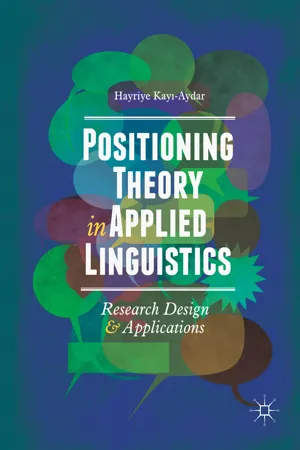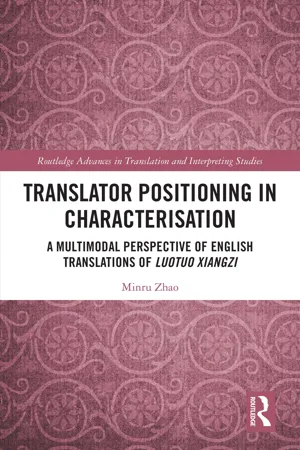Languages & Linguistics
Literary Positioning
Literary positioning refers to the strategic placement of a writer or text within a literary tradition or discourse. It involves the deliberate use of language, style, and themes to situate the work within a particular literary context or to challenge existing literary conventions. This positioning can shape the reception and interpretation of the text by readers and critics.
Written by Perlego with AI-assistance
Related key terms
Related key terms
1 of 4
Related key terms
1 of 3
5 Key excerpts on "Literary Positioning"
- eBook - ePub
Positioning Theory in Applied Linguistics
Research Design and Applications
- Hayriye Kay?-Aydar, Hayriye Kay?-Aydar, Hayriye Kay?-Aydar(Authors)
- 2018(Publication Date)
- Palgrave Macmillan(Publisher)
2016 , p. 23). With all these constant shifts and changes in the world, language learning and teaching processes are becoming even more complex than before. I see a strong potential in positioning theory to understand this complexity and advance knowledge in the areas of learning and teaching additional languages.Positioning theory, as a “trans-disciplinary conceptual and analytical framework” (Slocum -Bradley, 2009 , p. 79), allows applied linguists “to adequately understand and address social issues, which are not bound by disciplinary divisions” (ibid.). Given its strong focus on social context , identities, and social interaction, positioning theory has much to offer in understanding the nature of interactions and participation in bi/multilingual contexts. Furthermore, positioning theory pushes us to rethink “taken-for-granted” story lines in the context of second/foreign language teaching and learning, cultural stereotypes (see Van Langenhove & Harré , 1994 ), as well as dichotomized constructs that describe learners or speakers of additional languages, characterizing SLA (see Canagarajah , 2007 ). Whitsed and Volet (2013 ) acknowledge, for example, that in the context of the internationalization of language education, “taken-for-granted story lines abound, for example, ‘the academically challenged and problematic international student ’ vs. ‘the less challenging domestic student’ story line” (p. 722). Positioning theory enables us to expose and challenge such story lines and assumptions. In the next section, I elaborate on the link between positioning theory and applied linguistics research, and further explain why positioning theory is relevant to applied linguistics. I then continue with a discussion about the relationship of positioning to a number of important applied linguistics concepts, such as culture , language socialization - eBook - ePub
Translator Positioning in Characterisation
A Multimodal Perspective of English Translations of Luotuo Xiangzi
- Minru Zhao(Author)
- 2023(Publication Date)
- Routledge(Publisher)
Landert, 2017 , p. 489). On the narratorial level (the level of communication between narrator and addressee), positioning can influence how the narrator evaluates a character. On the character level (the level of communication between characters), the positioning impacts how characters evaluate themselves and others.Due to its significance, scholars have explored the concept of positioning from different perspectives under a wide range of terms. Some subsumed it under the notion of ‘expressivity’ (e.g. Bednarek, 2011 ), which is inclusive of positioning, values, ideology, evaluations, and emotionality. Some have treated positioning as a component of ‘stance’ (e.g. Conrad & Biber, 2000 ; Du Bois, 2007 ; Kärkkäinen, 2006 ; Keisanen & Kärkkäinen, 2014 ; Landert, 2017 ). For example, Bois (2007, p. 163) divided stance-taking into three simultaneous acts: evaluating objects, positioning self and others, and aligning with other subjects. Others have studied positioning from the perspective of SFL, under the framework of Appraisal (e.g. Bartley, 2020 ; Martin & White, 2005; Su & Hunston, 2019) or Evaluation (e.g. Hunston, 2011 ; Hunston & Thompson, 2000 ; Macken-Horarik & Issac, 2014 ). In addition, the concept of positioning overlaps with several terms, such as ‘(inter-) subjectivity’, ‘point of view’, and ‘voice’ (Hermans, 2020 , p. 423).Although there are various discussions related to this concept, no consensus has been reached on how to define it, which subtypes it should include, and how to accurately divide the boundaries among different types of positioning (see Keisanen & Kärkkäinen, 2014, p. 295). Some studies defined positioning as “the act of situating a social actor with respect to responsibility for stance and for invoking sociocultural value” (Du Bois, 2007 , p. 143). Specifically, stance-takers can simultaneously select a position along an affective scale (which expresses emotions, such as glad or sad) and an epistemic scale (which expresses the reliability or certainty of information, such as sure) (Davies & Harré, 1990 ; Du Bois, 2002 , 2007 ). In addition to the affective and epistemic positioning, some studies have incorporated evaluative positioning (which expresses assessments along a scale from good to bad, such as kind or greedy) into the classification (e.g. Keisanen & Kärkkäinen, 2014 ). In contrast, others divided positioning into attitudinal stance (which covers affective and evaluative stance), epistemic stance, and style of speaking stance (which expresses the speaker’s or the writer’s comments on the communication itself, such as generally speaking) (e.g. Biber, Johansson, Leech, Conrad, & Finegan, 1999 - eBook - ePub
- Alison Hicks, Annemaree Lloyd, Ola Pilerot(Authors)
- 2023(Publication Date)
- Facet Publishing(Publisher)
5Locating Information Literacy within Discursive Encounters: A Conversation with Positioning TheoryAlison HicksPositioning theoryPositioning theory provides a framework through which the fine-grained dynamics of social episodes can be studied. At the heart of this work lies the position, a sociological concept that has been used to refer to a person’s status or constellation within a community (Bjerre, 2021, 266). However, beginning in the 1990s, position took on a new meaning as Rom Harré and other constructionist and post-structuralist theorists started to reconceptualise positions and related acts of positioning in terms of the distribution of rights and duties within a particular interaction. Drawing attention to how people locate themselves (and others) within conversation, this development also introduced a more overt focus on the ways in which the position obliges and limits the potential to act. Positioning theory was labelled as a theory in 1999 (Van Langenhove and Wise, 2019). Still relatively unchanged since then, it constitutes a multi-layered framework through which the impact of living in ‘an ocean of language’ (Harré, 2008, 32) can be analysed, including how people construct themselves – and have their opportunities and worlds constructed – through social encounters.For information literacy, positioning theory presents an opportunity to consider the role that granular, social interactions play in shaping information landscapes (Lloyd, 2006). Involving a shift from thinking about information literacy itself to the ‘flow of talking and writing’ within which information literacy actions are set (cf. Moghaddam, Harré and Lee, 2007, 4), a focus on position-positioning relationships draws attention to language use and interaction, whether this is written, spoken or material. It also extends research examining the social sites of information practice (e.g. Tuominen, Savolainen and Talja, 2005; Lloyd, 2005) by interrogating the conditions that shape information environments, including the impact that discursive constructions have upon what kinds of knowledge are valued, who can access learning opportunities and claims about how information literacy should happen. In focusing on social encounters, this chapter follows Davies and Harré (1990, 45) to define discourse as an ‘institutionalised use of language and language-like sign systems’ that both constitutes and forms a resource through which speakers and hearers negotiate social practice (Davies and Harré, 1990, 62). - eBook - ePub
Heteroglossia and Language Play in Multilingual Speech
Pedagogical and Theoretical Implications
- Darren LaScotte, Elaine Tarone, Darren LaScotte, Elaine Tarone(Authors)
- 2024(Publication Date)
- De Gruyter Mouton(Publisher)
Chapter 7 Language play and social positioning in L2 narrative retellsDarren LaScotteKendall KingAbstract
Research on language play in a second or foreign language (L2) has focused on the immediately relevant social context and setting, showing how speakers manipulate elements of their language(s) for sarcasm, irony, or personal amusement (e.g., Broner and Tarone 2001 ; Forman 2011 ; LaScotte and Tarone 2019 ). This chapter expands upon this work by demonstrating the need to take into account not just the immediate social context as a frame of reference, but also the broader community and network of persons (Hymes 1994 ). Grounded in Bakhtinian sociocultural theory, this chapter takes up the construct of social positioning (Davies and Harré 1990 ) to analyze L2 narrative retells and to demonstrate the importance of the broader cultural and historical context in everyday L2 talk. In positioning theory, identity is constantly (re)produced and negotiated in and throughout discourse and emerges at different levels – in the storyworld (Level 1), vis-à-vis one’s interlocutor during the speech event (Level 2), and in relation to dominant discourses in society (Level 3) (see Bamberg 1997 ; De Fina 2013 ). Applying this theoretical lens to interview data collected with L2 speakers of English, we analyze how speakers use language play to position themselves in relation to other characters in the storyworld and to their interlocutor, and how such positioning reflects and simultaneously constructs larger social ideologies and discourses (De Fina and King 2011 ). This work demonstrates the value of close analysis of L2 language play in broader social and political contexts. Theoretical and practical implications for L2 teaching and learning are discussed.1 Introduction
Inherent to the study of language, a social tool, are its social dimensions. Through grammatical, lexical, and/or phonological forms, language carries social meanings that can index various personal, communal, and/or societal circumstances, histories, ideologies, emotions, and identities. And, as such, studying language requires that one take into account not just the immediate social context as a frame of reference but the whole community and network of persons (Hymes 1994 ). Therefore, in the study of language and, more specifically, discourse, we argue that social context includes not just the immediate interactional setting in which discourse and its verbal and nonverbal aspects take place, but also includes what has previously been said and any shared cultural or historical knowledge belonging to the community of speakers (Gee 2011 ). Such inclusion allows for a deeper understanding of the different ways in which linguistic forms are associated with and/or become associated with what Bakhtin called “the ‘social languages’ of different classes, ethnic groups, age groups, generations, and so on” (Maybin 2008 - eBook - ePub
Language, Text and Context
Essays in stylistics
- Michael Toolan(Author)
- 2016(Publication Date)
- Routledge(Publisher)
Mulvey (1981) . However, positioning is simply asserted by these theorists; there is little attempt to trace formal features in the text which might serve as markers, to the reader, of this positioning.THE POSITIONING OF THE READER
It is surprising that in literary studies there has been so little work which considers the positioning of the reader at any length. There have been theories of reader-response and reception theories (e.g. Suleiman and Crosman 1981 ), but they have been primarily concerned with examining a consensus of interpretation through the notion of the implied or ideal reader. Even those critics who do consider reader positioning pay little attention to the formal features in the text which signal the dominant reading to the reader. In order to formulate a mode of analysis which considers formal features and the way they relate to context and reader address, I would like to consider the work of Louis Althusser on interpellation and obviousness and then go on to discuss the work of critics who have been concerned with the notion of positioning of the reader.Louis Althusser’s work on ideological state apparatuses (1984: 1–60) is an interesting combination of Marxist theory and psychoanalysis, and has received a great deal of attention. The basis of his argument is that ideological state apparatuses are those elements whose indirect effect is to reproduce the conditions of production within a society. In order for a capitalist society to continue to function, workers must be made to recognize their position within that society and accept those roles. This happens through two main mechanisms: the repressive state apparatuses, consisting of the police, the army, and the state, which achieve this aim through force or violence; and the ideological state apparatuses, consisting of the educational system, the media, and so on, which achieve this aim through a constant barrage of images and information which map out the role of the subject. The effects of repressive state apparatuses have been well documented and it is on the ideological state apparatuses that Althusser concentrates. He describes the way in which individuals are called into a position of subjecthood – when you recognize your role/s in society, you become a subject in both senses of the word: you are a subject in that you are an individual psyche, and you are also subject to the state and authority. In this way, you are forced to mis/recognize the imaginary (i.e. ideological) conditions of your relation to the means of production. Althusser states that interpellation or hailing is one of the mechanisms whereby this is achieved; he gives the much-cited and maligned example of a police officer in the street calling ‘Hey you’. In the process of turning round, the individual has recognized not only her/himself as an individual who may be guilty of something, but also as a subject in relation to a position of authority. Thus, interpellation constructs the subject into a role or position in the very act of hailing it.
Index pages curate the most relevant extracts from our library of academic textbooks. They’ve been created using an in-house natural language model (NLM), each adding context and meaning to key research topics.
Explore more topic indexes
Explore more topic indexes
1 of 6
Explore more topic indexes
1 of 4




